When it comes to shaping your guitar’s tone, there are few tools more valuable to have in your arsenal than an EQ pedal. Graphic equalizers are commonly used in the mixing process in a recording studio, but recent advances in technology have now made it possible to have EQ on your pedalboard.
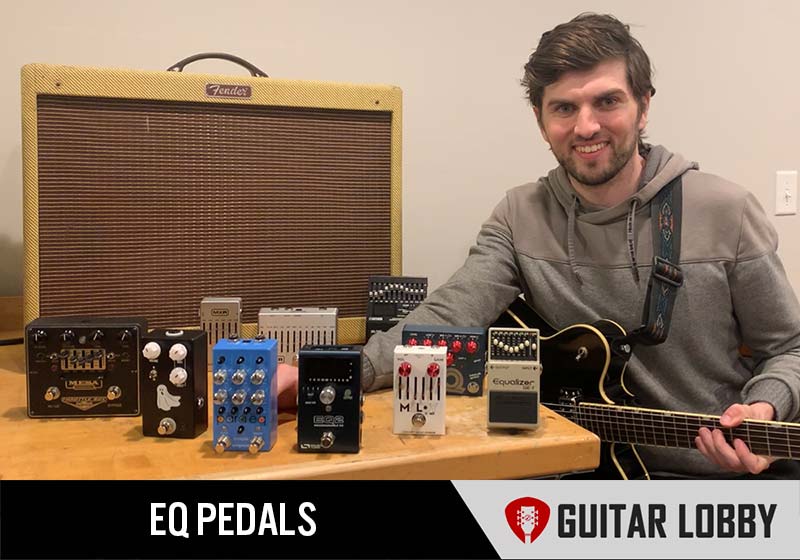
It can be difficult to sift through all of the options available when purchasing new effects pedals due to the sheer volume of quality products available. It’s important to establish what functions you require from a pedal before deciding on the right one for your needs.
I’ll start this article by reviewing the best EQ pedals at each price point. I’ll go into detail on the best aspects of each model and how they can enhance your live guitar setup. If you want to learn more about EQ pedals before reading reviews, check out our buying guide at the bottom of the page here.
Table of Contents
- Here Are the Best EQ Pedals
- Factors to Consider When Choosing an EQ Pedal
Here Are the Best EQ Pedals
1. Empress ParaEQ MKII Deluxe (Editor’s Choice)
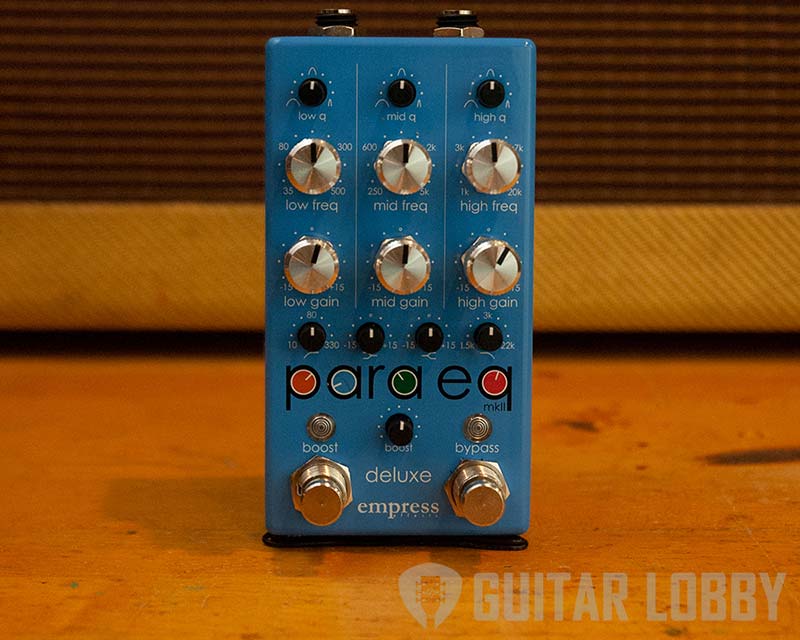
| Estimated Price | $349 |
| Type | Analog |
| Effects | EQ |
| Connectivity | 1 x ¼” Input, 1 x ¼” Output |
| Power | 9 VDC 300mA |
My Review: The ParaEQ MKII Deluxe is one of the more exciting pedals I’ve ever acquired. A big kudos to Empress Effects for giving us this stellar upgrade on an old fan favorite, the ParaEQ. Besides the awe-inspiring legacy of its predecessor, The ParaEQ MKII Deluxe sets itself apart from the competition with 107.9dB signal-to-noise ratio and a 27V internal headroom, which is very effective at avoiding clipping. The incredibly low 0.03% gain keeps my sound true to the instrument, and the 12dB/oct high-pass and low-pass filters allow me to get creative with sound sculpting. These factors, combined with several other exciting new controls, have turned this stompbox into a must-try tone-shaping machine.
Despite being all-analog, this pedal is anything but traditional, as you can make out from the pictures of my newly acquired MKII Deluxe. There are three columns and four rows of controls to manage the lows, mids, and highs both in gain and frequency. Although it’s a familiar 3 bands, sound-shaping goes to a whole new level with some of the deluxe model’s fully sweepable features.
One of my favorite features to experiment with has been the fully sweepable “Q Controls.” This feature is only available on the Deluxe version of the MKII and, in my opinion, is an upgrade that makes the price difference of the MKII Deluxe worth considering over the non-deluxe version of the MKII. There have been plenty of applications in which I like to open up the Q range of a band, but I find this feature most useful when I isolate and narrow the Q range to remove specific frequencies that are problematic.
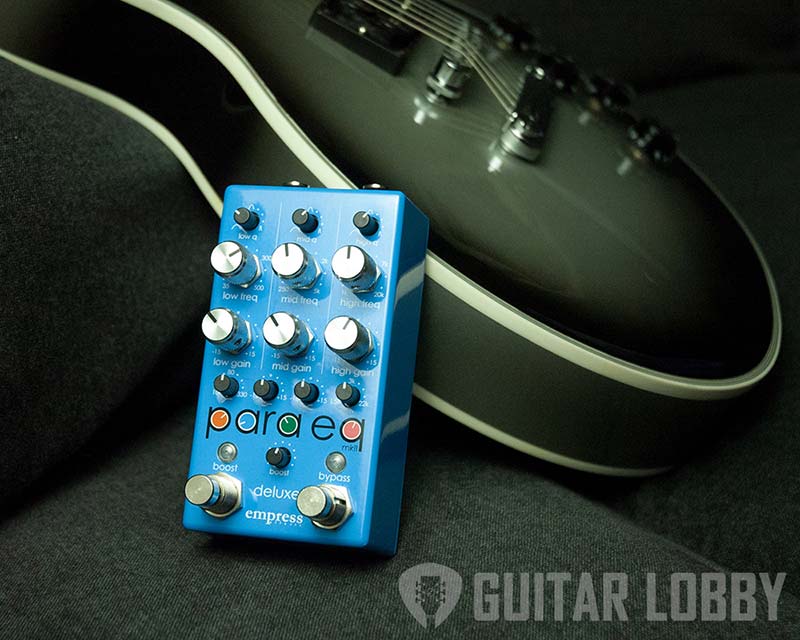
I also love the high and low pass shelving filters. These sweepable pots can be powerful for limiting certain frequencies to optimize your signal for specific applications. One of the guitars I play often is a Gretsch hollow body guitar which I sometimes have issues with feedback depending on the setting. I have found that tightening up the low filter to reduce bass frequencies is often a big help. Using the Q Controls to remove specific frequencies is also a powerful function for feedback elimination. The ability to tighten the shelves also allows me to fine-tune a range for my guitar to sit nicely within a given mix.
As icing on the cake, this pedal has a foot-switchable boost of up to 30 dB! I typically use this as a clean boost for solos, but it could also be used for some overdrive in your tube amp.
Who This is Best Suited for: I recommend this pedal for those who have been looking to fill the void left by the discontinuation of the 2010 Empress ParaEQ. The MKII Deluxe has built responsibly upon the original design to become an ultimate tone-sculpting machine. This pedal has a versatile range of applications for both live and studio applications.
Bottom Line: A highly versatile EQ pedal that brings broad tonal shaping with the freedom to hone your sound to exactly what you had in mind. The low noise circuitry and 27V functionality combined with intuitive controls ensure you get squeaky clean tones and studio-grade sonics. With this EQ pedal, you’ll never have to worry about your instrument’s authentic character getting lost.

2. BOSS GE-7 (Best Value)
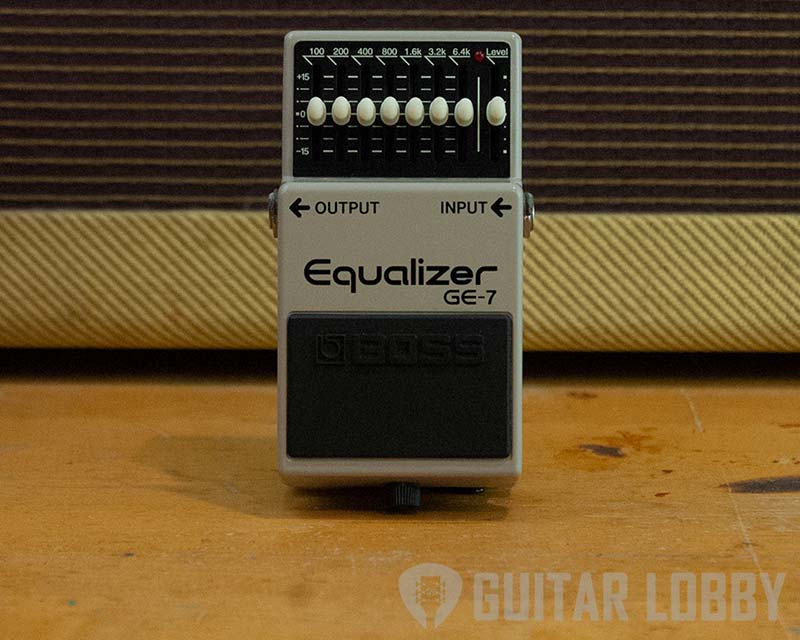
| Estimated Price | $120 |
| Type | Digital |
| Effects | EQ |
| Connectivity | 1 x 6.35mm Jack Input, 1 x Output |
| Power | 9 VDC 100mA |
My Review: It seems that BOSS has a pedal to suit every need of a guitarist. Among equalizers, the GE-7 is touted by many guitarists as a must-have. Like other Boss pedals, the GE-7 became popular for three reasons. Firstly, it is exceptionally durable and road-worthy. Secondly, its classic stompbox design is easy to use and uncomplicated. Finally, it is a great value for the price.
The GE-7 is a 7-band graphic EQ pedal that lets you tweak all of the main frequency bands of your chosen instrument. Whether you play guitar or bass, this pedal will do the job. And do it well. What thrilled me the most were the seven individually adjustable faders that helped me quickly shape the frequency response and get the desired sound.
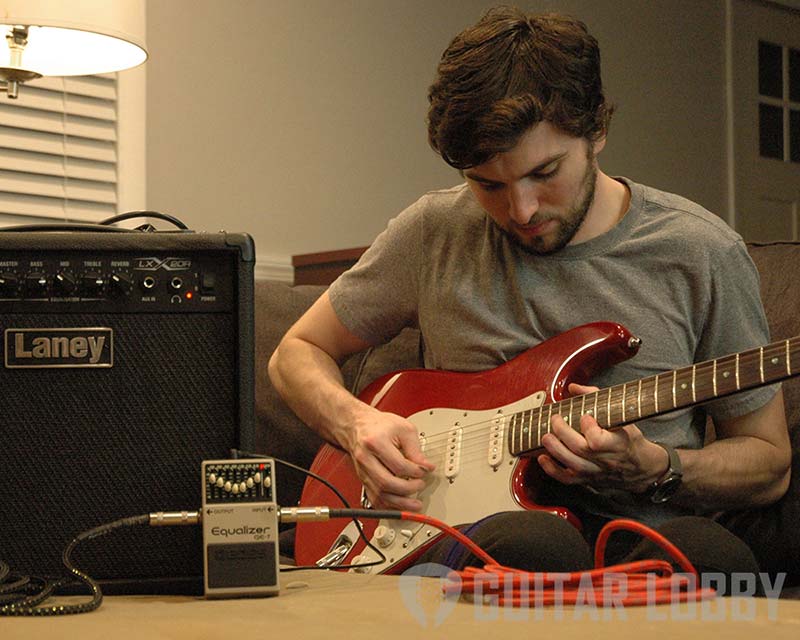
As the name says, this Boss pedal offers 7 EQ bands along with up to 15 dB of boost or cut capabilities. It has allowed me to test out a wide range of tones to find the ones that suit my style of music the most. I could also see the shape of the EQ on the fly thanks to the simple-to-read graph design. Still on the fence? Then maybe this will help: there’s a level control on the far right-hand side of the pedal that provides an easy way to balance the output with your clean signal, and the visible LED light signifies when the GE-7 is active. Imagine you get all these features without breaking the band!
Who This is Best Suited for: My gut tells me that the fans of simplistic, easy-to-use pedals will love the BOSS GE-7. It has all of the basic controls you need from a graphic equalizer, and with 15 decibels of cut/boost, it’s helped me shape my tones just the way I like them.
Bottom Line: The BOSS GE-7 is a straightforward pedal with the signature stompbox design that the manufacturer is known and loved for. 7-bands of graphic EQ is more than enough to sculpt your tone, and the level control also comes in handy. There’s nothing flashy about this pedal, but it functions at a high level and is well worth the cost. Overall, I would say it is the best EQ pedal for the money.

3. JHS Haunting Mids
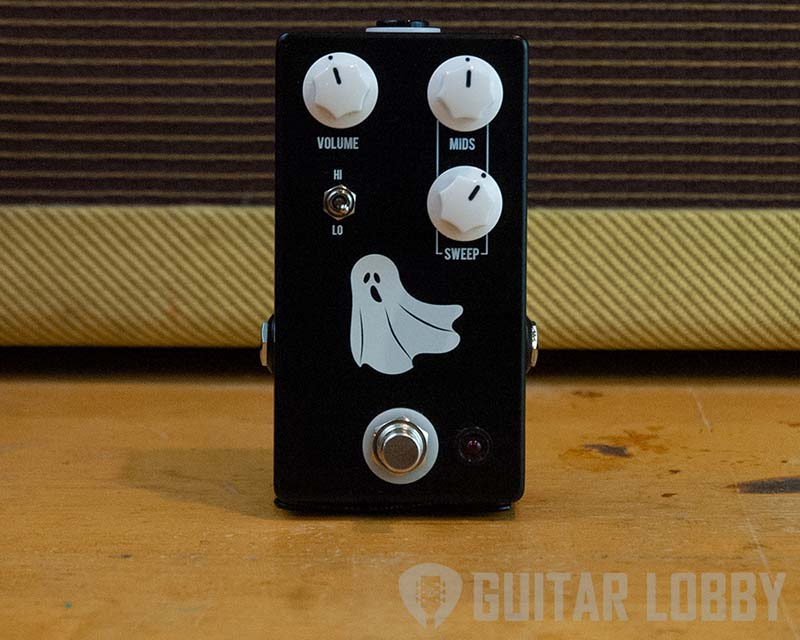
| Estimated Price | $150 |
| Type | Digital |
| Effects | EQ |
| Connectivity | 1 x 6.35mm Jack Input, 1 x Output |
| Power | 9 VDC 100mA |
My Review: The JHS Haunting Mids has been on my dream pedal list for quite some time. After finally buying and testing it out, here’s what I think: It’s hauntingly effective in what it claims to deliver – manipulate, boost, and scoop the midrange frequencies of a guitar.
This preamp pedal works perfectly in conjunction with an overdrive, distortion, or fuzz pedal, as it hones in on the most prominent frequencies that these effects produce and gives them a new lease of life.
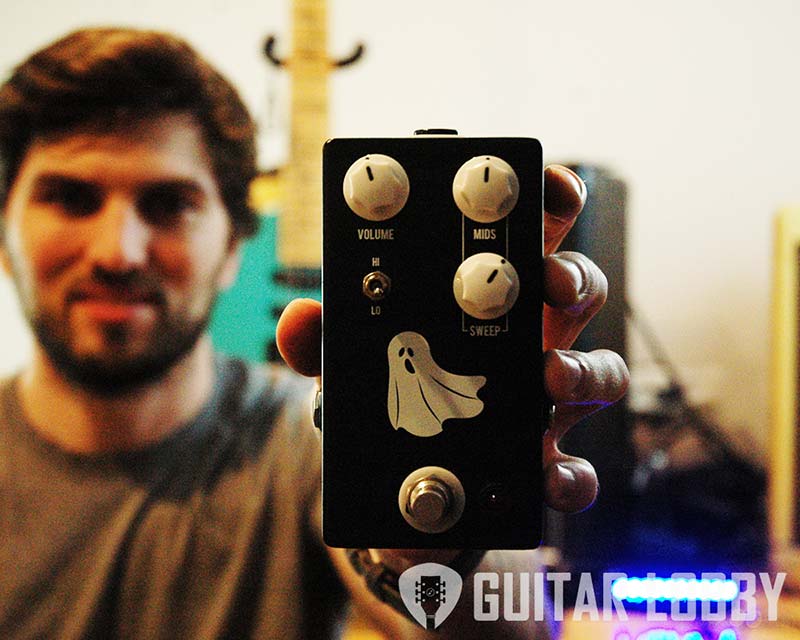
With its continuously sweepable midrange, up to 15 decibels of cut or boost, and a broad or narrow Q toggle, the Haunting Mids pedal transforms your tone into a whole new monster. Using EQ pedals specifically for fine-tuning other effects is often overlooked by guitarists, but when you consider it, it seems like an obvious way to get the best out of them.
In addition to acting as a mid-range EQ pedal, the JHS Haunting Mids also makes a great gain booster. It offers up to 10dB of clean boost with flat EQ, so you can quickly boost your dynamics to cut through the mix for a solo or melody. The lo/hi toggle switch activates with a broad or narrower bell curve, too.
It’ll not only make a great addition to the pedalboard for its outstanding midrange tweaking abilities but also because of the way it looks. I love how this sleek little pedal stands out on my rig with its quirky ghost artwork on the top panel.
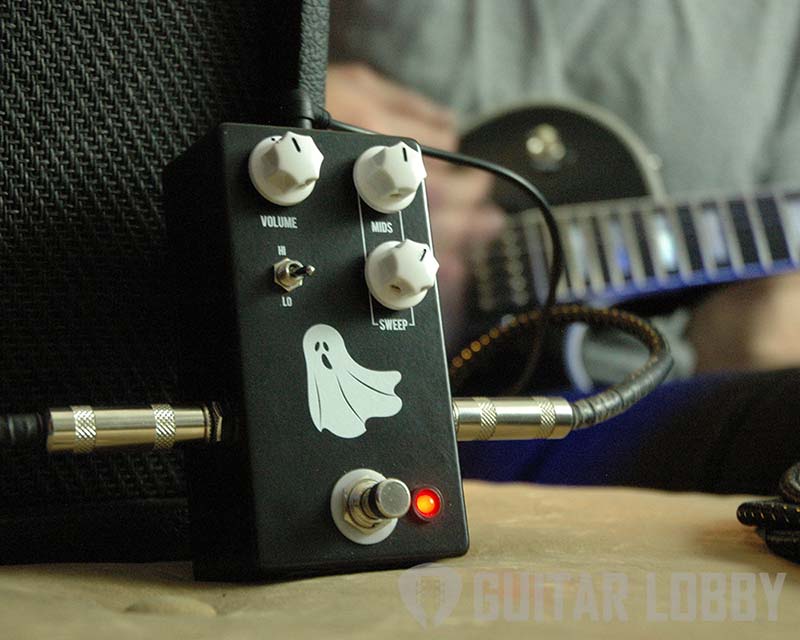
Who This is Best Suited for: I’d highly recommend this pedal to guitarists who use a lot of “dirt” based effects like distortion, overdrive, or fuzz. It performs best as an EQ pedal that is tasked with getting the best out of your other effects, especially if they are bathed in saturation!
Bottom Line: JHS keep on pumping out quality pedal time after time. The Haunting Mids pedal is unique in that it is best suited to enhancing your grittier pedals, thanks to its exceptional ability to boost the midrange frequencies. It also has several other interesting functions, like 10 decibels of clean gain and a lo/hi toggle for affecting the bell curve.

4. Tech 21 Q-Strip
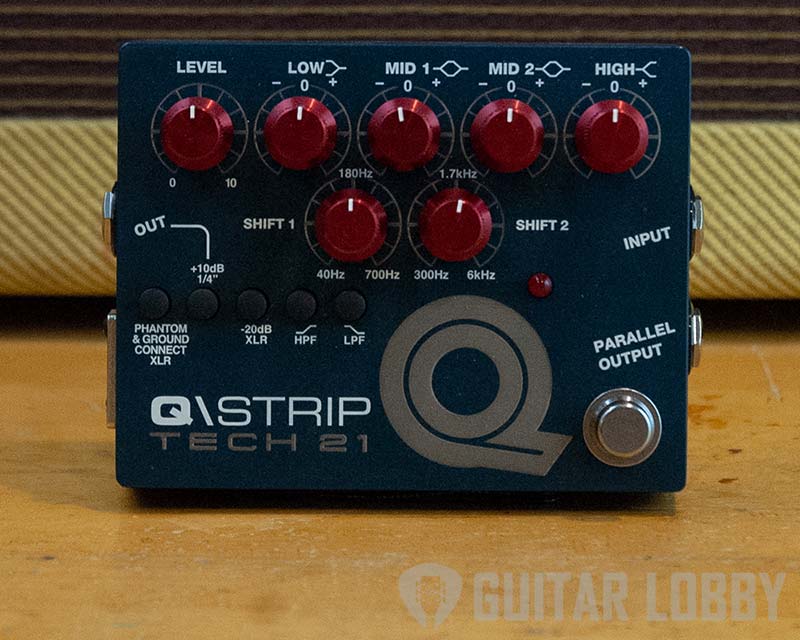
| Estimated Price | $270 |
| Type | Digital |
| Effects | EQ |
| Connectivity | 1 x 6.35mm Jack Input, 2 x Output |
| Power | 9 VDC |
My Review: The Tech 21’s Q Strip is one of my all-time favorite EQ pedals for many reasons. It’s a vintage-style equalizer offering virtually endless tone-tweaking possibilities. Inspired by the original recording consoles of the 60s and 70s, the Q Strip is my go-to pedal whenever I want to add warmth and punch like those legendary consoles.
The boards within the pedal are hand-wired, with utmost care being taken over the design and construction. The Q Strip is essentially a direct input box that is kitted out with MOSFET analog circuitry. It’s 100% analog, like most Tech 21 product lineups. So, just in case you’re looking for a digital pedal, this might not be the one for you. I also wouldn’t call it the most user-friendly pedal, as its design and features can take some getting used to. But once you get the hang of it, it’ll become your go-to tool, capable of completely invigorating your guitar’s tone.
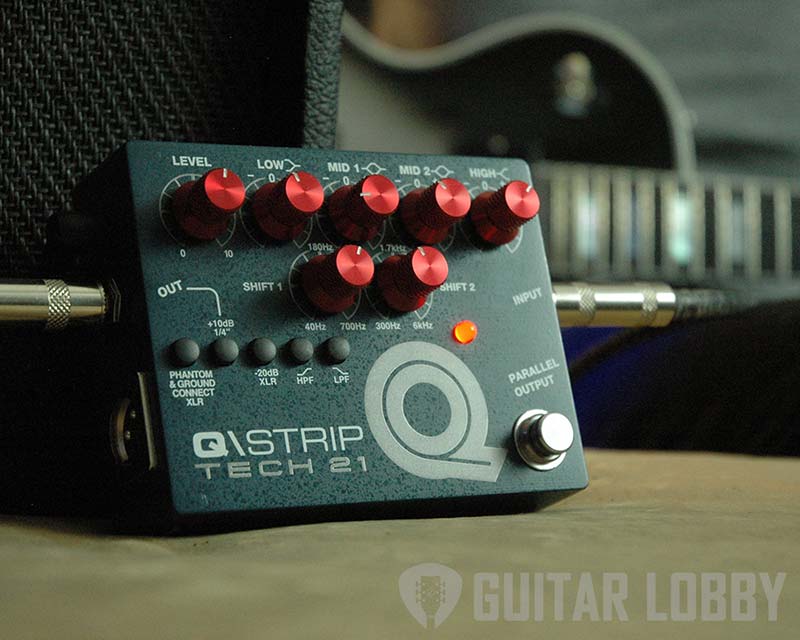
Did I mention there are four bands of studio-quality EQ onboard the pedal? Each one was inspired by a particular classic console module, and the definition is instantly audible when you flick between the settings. Meanwhile, the bands are split into two parametric mids and singular high and low shelving filters, giving you complete control of the output.
There are also separate high-pass and low-pass filters that can be used to quickly shape the frequency response of your instrument. When the LPF is used with the EQ section, you can simulate various curves of speaker cabinets and blend the results with your other effects pedals. The HPS is useful for sweeping filters or cutting out any of the problematic low-end frequencies that sometimes occur when using an instrument with direct input.
Who This is Best Suited for: Let’s just say if you consider yourself to be an experimental guitarist, the Tech 21 Q strip could be the perfect EQ pedal for you. As I mentioned earlier, it’s slightly complex to get your head around at first. So, go ahead with your tinkering and exploring to become familiar with all the capabilities of this EQ pedal. Once you get into the swing of things, you’ll be able to operate it more intuitively.
Bottom Line: This pedal is a truly dynamic EQ. It offers everything you would want from an ideal parametric EQ pedal while also providing you with a platform to experiment and find unique uses for the various settings. It’s certainly given me a vast library of usable sounds, and I hope it does the same for you.
Popular Related Article: The Best Looper Pedals Currently on the Market

5. BOSS EQ-200
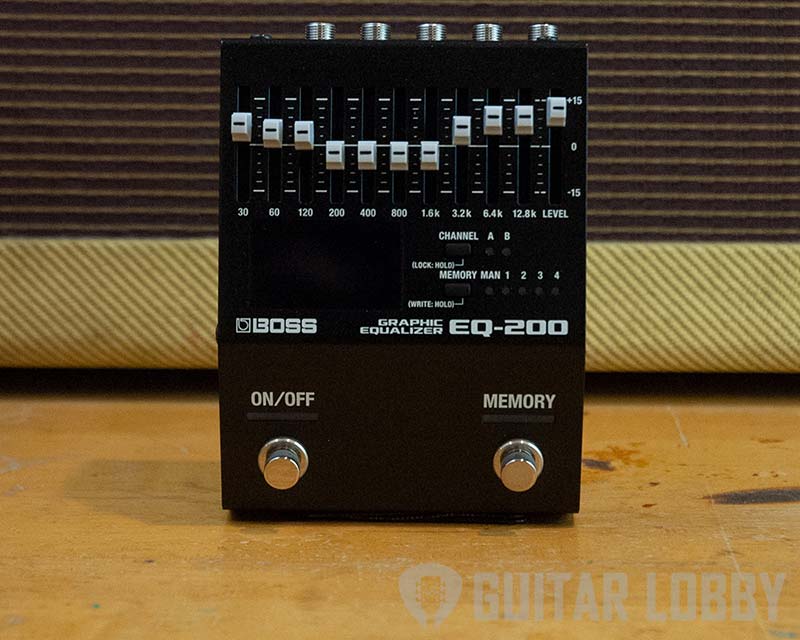
| Estimated Price | $290 |
| Type | Digital |
| Effects | EQ |
| Connectivity | 1 x 6.35mm Jack Input, 2 x Output |
| Power | 9 VDC 170mA |
My Review: Here’s another Boss EQ pedal that I tested, and the first thing I noticed was that it doesn’t boast the brand’s renowned stompbox design like the GE-7 but rather a streamlined design. It certainly helped downsize my pedalboard while offering tons of sophisticated features across the board.
The EQ-200 is a graphic equalizer with many useful digital features and a frequency range that covers all bases. It offers up to 15 dB of boost or cut per slider, and with the global level control, you can use it as a gain booster if the need arises. It has four independent memory slots that can be pre-programmed and used to save your preferred EQ settings. This saves me a lot of time and trouble by allowing me to simply plug in, cycle through the setting I want, and start playing. Meanwhile, the onboard display laid out the active EQ curve in front of me as clear as day.
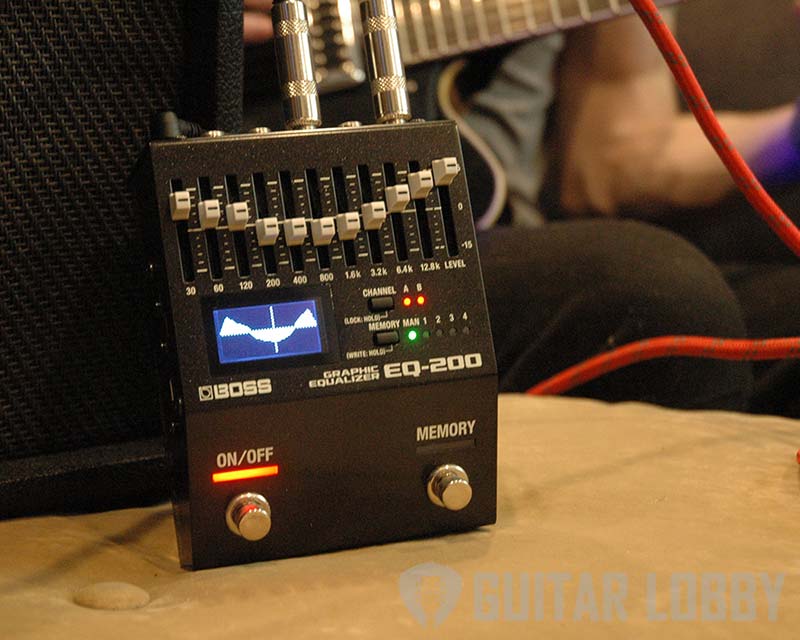
Another feature I really liked is the dual EQ. That’s right. The EQ-200 pedal has two onboard EQs that can be configured in numerous ways. There’s the standard stereo setting, parallel operation, series, or by using insert function. You can also integrate external effects pedals and use the EQ-200 for pre/post equalization. This means you can run two different 10-band EQ settings simultaneously. A really helpful feature for musicians operating dual (wet/dry) amplifier rigs.
I was also impressed by the EQ-200’s pristine sound quality. I found the sound super clean. There’s no unwanted noise caused by the pedal, and it accentuates the natural tone of your guitar or bass. With a stereo input/output, it could even be used for a keyboard too. The versatility of this pedal continues to astound me, and I am still not done discovering all its amazing features.
Who This is Best Suited for: If you’re already a fan of BOSS’ range of stompboxes, you’ll be amazed by the design and functionality of the EQ-200. It’s a very detailed pedal and, in my opinion, would be best suited to someone who has a clear idea of the EQ settings they desire. It’s also great for multi-instrumentalists.
Bottom Line: The BOSS EQ-200 is small but mighty when it comes to sound-shaping prowess. This graphic EQ pedal gives you complete freedom over your instrument’s tone. With two independent 10-band EQ engines, you can store your preferred presets and access them with the press of a button.

6. J.Rockett Audio Designs Melody OD 6-Band EQ
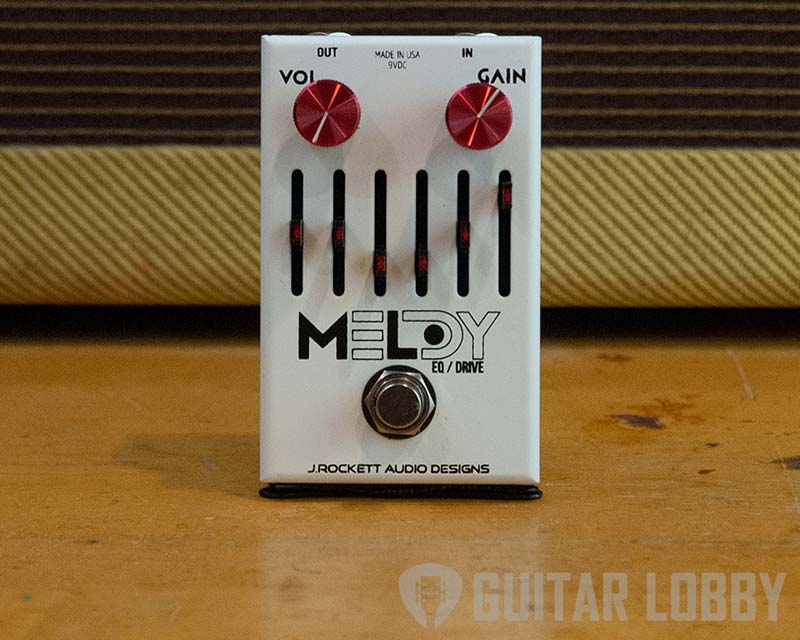
| Estimated Price | $200 |
| Type | Digital |
| Effects | EQ, Overdrive |
| Connectivity | 1 x 6.35mm Jack Input, 1 x Output |
| Power | 9 VDC 20mA |
My Review: As someone who loves the sound of overdriven guitars, I was instantly drawn to J.Rocket Audio Designs Melody OD 6-Band EQ. This clever overdrive pedal boasts tone-tweaking capabilities, saving you the need to buy a separate EQ pedal to manage the tone. So, instead of needing to purchase multiple EQ pedals to tailor the frequency response of wet/dry signals, I got the best of both worlds with this J.Rocket option.
The Melody OD offers warm and authentic overdrive to cater to a variety of genres, including jazz, blues, and rock guitar. I didn’t exactly find the saturation levels to be too extreme. Instead, it helped in adding slight breakups to my tone, similar to the valves being pushed to their limits in a tube amplifier.
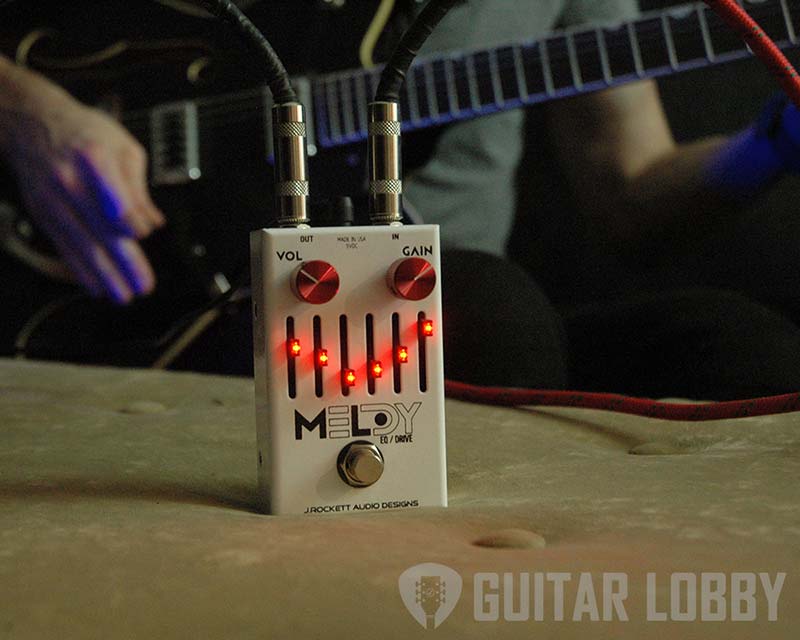
Along with the high-quality overdrive capabilities offered by this pedal, it also has a 6-band graphic EQ. And the sound only gets better with a generous 18 dB of boost or cut on each frequency.
Instead of being stuck with bands you may not use, the brand has carefully selected only those frequencies that offer maximum compatibility with the overdriven tones produced by the pedal. Plus, true bypass switching plays a huge role in keeping the tone consistent.
Who This is Best Suited for: This intelligently designed and highly durable is an excellent addition to your pedalboard. If you’ve been planning to buy a drive pedal at some point, it might be worth considering doubling up with the Melody OD. It offers a 6-band EQ, so you can adjust the frequency response whilst adding some crunch to your guitar.
Bottom Line: The J Rockett Audio Designs Melody OD is a unique pedal as it combines overdrive and graphic EQ. There are plenty of usable sounds that you can get out of this pedal. I am aware that many guitarists recommend using separate EQ pedals specifically for controlling the tone of your dirt pedals. But with this offering, you can combine the two to save money and space. The overdrive produced is warm and natural sounding, and with six bands of equalization, there are plenty of sound tweaking options to explore.

7. MXR M108S
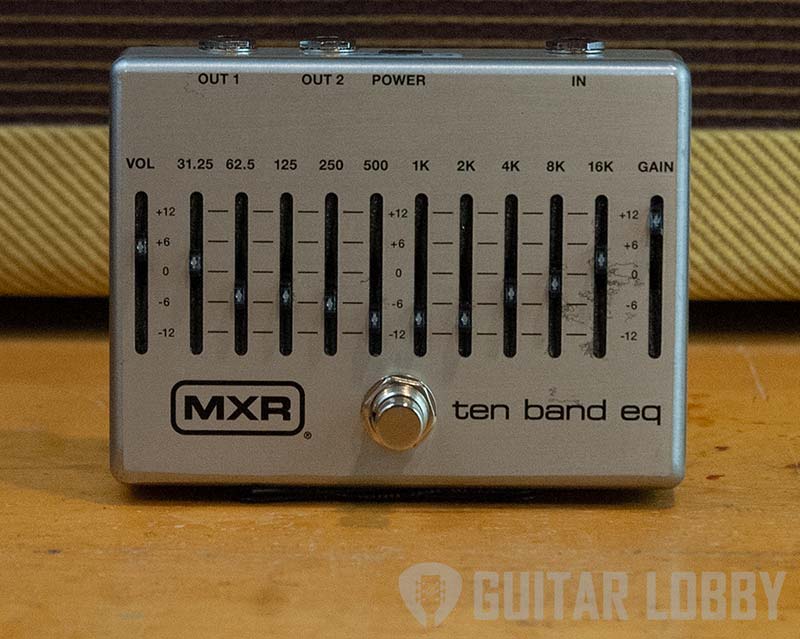
| Estimated Price | $150 |
| Type | Digital |
| Effects | EQ |
| Connectivity | 1 x 6.35mm Jack Input, 2 x Outputs |
| Power | 9 VDC 100mA |
My Review: While testing the MXR M108S, suddenly, its raging popularity started making sense to me. The 10-band EQ pedal helped me achieve complete control over the tone of my guitar. Or bass, if that’s the instrument you play. I also noted that Fine-tuning bass, treble, and midrange frequencies and honing in my preferred sounds felt incredibly easy.
With 10 independent sliders that are responsible for thoughtfully selected frequency bands, this graphic EQ boasts great precision. Each EQ slider on the MXR M108S can be boosted or cut by up to 12dB, so there’s plenty of room for boosting or scooping. The pedal allows you to tailor the output of your instrument to suit the acoustic environment you are playing in. For example, when I tested it and found a bass trap in the room, I could easily remove some of the problem frequencies by adjusting one or multiple faders.
I also found the dual outputs to be a thoughtful addition. You can use this feature to split your wet and dry signals into two amplifiers. Due to the power of the pedal, it operates at 18-colts of power to ensure that you get maximum headroom even if you run multiple pedals into the M108S.
In addition to the frequency-adjusting sliders, there are also volume and gain controls to keep your levels consistent. There’s also true bypass switching to preserve the integrity of your dry tone, and the pedal is housed in rugged aluminum, so it’ll have no issues enduring the rigors of touring, recording, and practicing.
Who This is Best Suited for: Whether you play electric guitar, electric-acoustic guitar, or bass, this pedal will revolutionize your tone. It’s like having a VST plugin on your pedalboard. The 10-band EQ is highly detailed, so if you’re the kind of musician who likes to fine-tune their sound with absolute precision, this is the pedal for you!
Bottom Line: The MXR M108S 10-band EQ pedal is an accurate and intuitive graphic equalizer. I found it pretty straightforward to operate and solidly built to ensure longevity. No matter what type of sound you want to create, the 10 adjustable faders give you the freedom to cut or boost a range of frequencies until you find the sweet spot of your instrument.

8. Source Audio EQ2
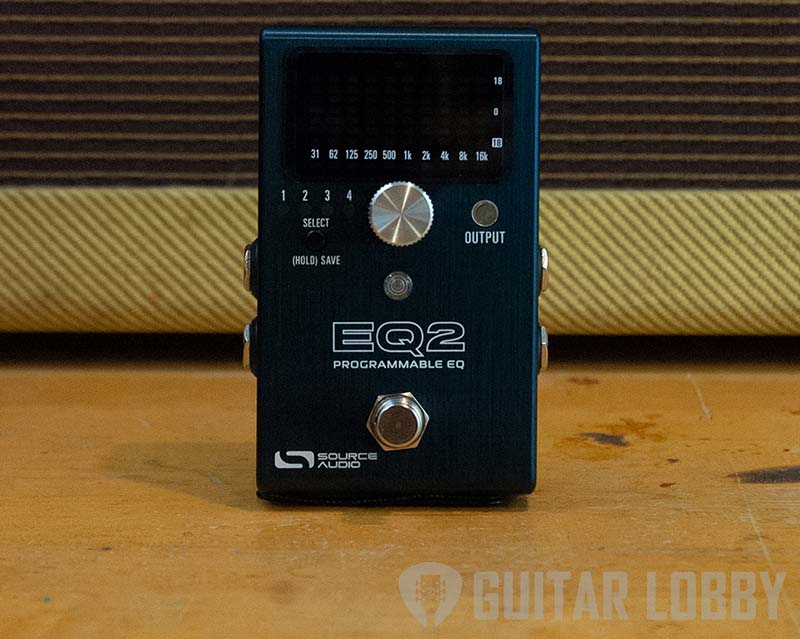
| Estimated Price | $289 |
| Type | Digital |
| Effects | EQ |
| Connectivity | 2 x ¼” Input, 2 x ¼” Output |
| Power | 9 VDC 100mA |
My Review: If I had to describe the Source EQ2 in a line, I’d call it a state-of-art EQ pedal that’s almost ahead of its time, just like its predecessor, which was released back in 2011. Let’s just say the folks at Source Audio have done well at building upon the legacy of the earlier EQ to create an even more versatile, programmable equalizer pedal that is known to have wooed icons like David Gilmour and John Mayer.
The EQ2 uses a true stereo signal path and boasts the ability to simultaneously run two separate EQ curves on the left and right channels. But what struck me the most about this pedal are the ten fully adjustable bands, meaning you can shift the bands from along a frequency spectrum of 20Hz to all the way to 20,000 Hz! That too with a +/- 18 dB of cut and boost!
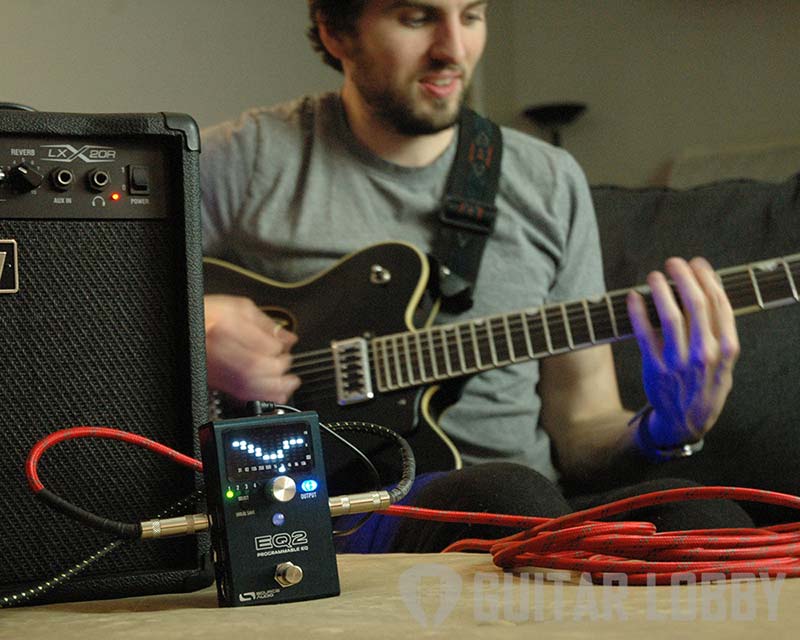
For me, this pedal has opened the gates to sound-shaping and fine-tuning tones with its multi-functional encoder knob. But just in case the single control knob is too simplified, there’s also a clever, clever Neuro app that takes ease of control to another level. This interactive software editor can be accessed on mobile or desktop, letting you manage everything about the equalizer. Here’s what’s impressive: With this app, you can shelve and high-pass frequency options or tinker around with different EQ curves or types for each channel.
In terms of the boost section, I found the 12dB volume boost good enough for amping up the solos and intros. But overall, it’s a little lacking when compared to the Empress MKII Deluxe’s30dB clean boost. Otherwise, there’s so much packed into this little pedal that it has actually replaced quite a few items on my pedalboard with its built-in chromatic tuner, customizable noise gate, and dynamic limiter. And did I mention its compact size? Measuring 4.5” x 2.75”x 2” (LxWxH), this pedal boasts a sleek stompbox form with a bright LED screen that displays the EQ curve.
It not only saves space on the pedalboard but also time. Once you’ve found a perfect sound for your acoustic, electric guitar, bass, or keyboard, you can save it using one of the eight onboard presets. Or just tap into any of its 128 presets using a third-party MIDI controller.
Who This is Best Suited for: I recommend this pedal for gigging musicians that can tap into the presets to get their go-to sounds. It’s also great for those who prefer small form with the added bonus of an onboard tuner.
Bottom Line: With EQ2’s graphic and parametric equalization, 10-bands, state-of-the-art editing app, and multiple callable presets, the world is truly your oyster when it comes to sound shaping AND storing.

9. Mesa Throttle Box EQ
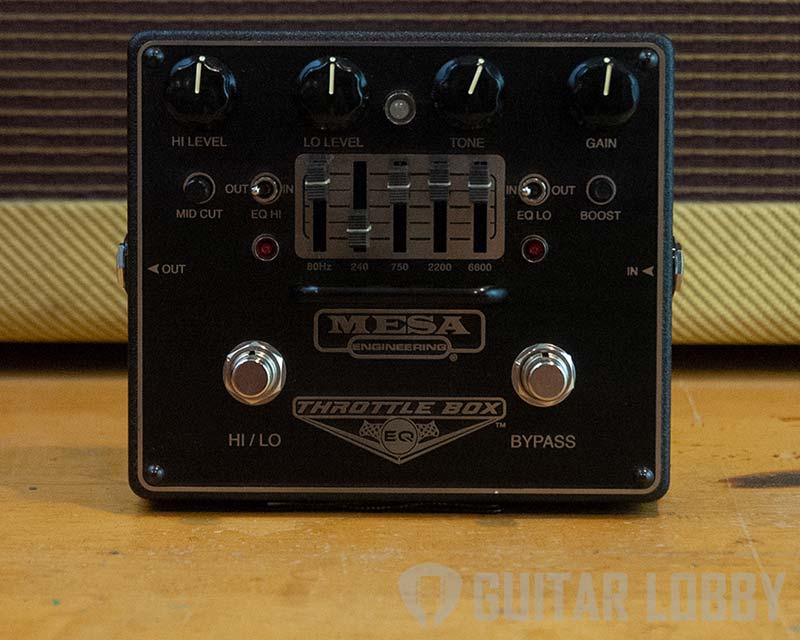
| Estimated Price | $250 |
| Type | Analog |
| Effects | EQ |
| Connectivity | 1 x ¼” Input, 1 x ¼” Output |
| Power | 9 VDC 100mA |
My Review: It’s no secret owning a Mesa amp or pedal is the stuff of dreams for guitar and bass players in the hard rock and heavy metal circles. But for those who have not yet acquired a Mesa amp, I believe that this pedal is a good starting point to sample the brand 5-band EQ legacy, and that’s exactly why I bought it.
The Throttle Box packs versatility and flexibility in an ultra-robust body. The stand-out feature is the 5-band Graphic EQ with +/- 12dB of boost or cut for each frequency band. I liked that there’s an independent knob for the high gain level that can be used to amp up the solos. I also found toggling between HI/LO gain modes breezy, thanks to the footswitch.
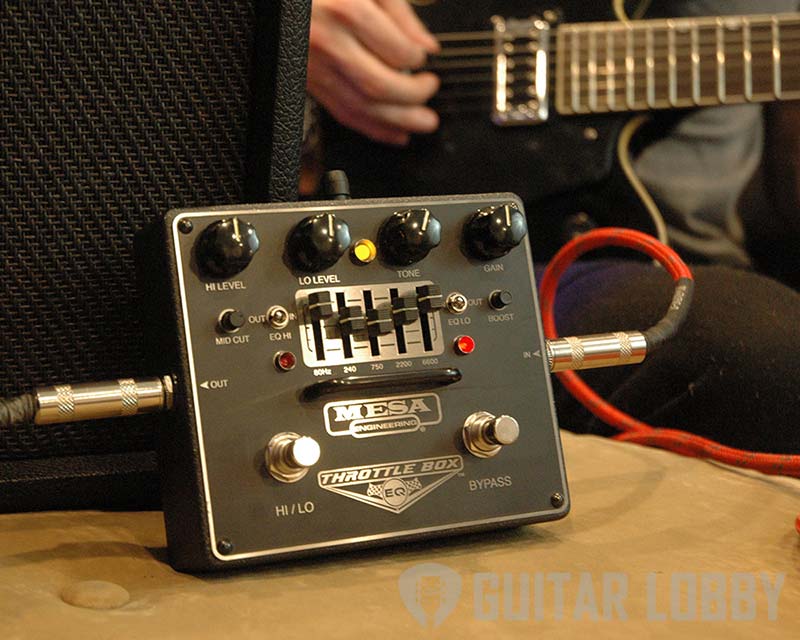
That’s not all. You can also turn the EQ switch on or off on each of the high or low gain channels for more flexibility. Plus, you get volume knobs for each of the modes, and a variable 20dB signal boost for an earth-shattering low-end. I also enjoyed working with the intuitive sliders to arrive at the right amount of punch, definition, and power for my sound.
Now, let’s talk about the two Throttle Box features that left me in a bit of a dilemma – the Mid-Cut knob and global boost. I appreciate Mesa’s thoughtfulness in adding them there to enhance tone shaping. But for me, the Mid Cut and boost that’s shared by both HI and LO modes made finding ideal tones a tricky affair.
I found the pedal quite versatile, even though the high gain is where it shines. But even when I dialed the gain back, I found myself in the rich overdrive territory that’s perfect for busting out some classic rock or even blues tunes. Not to mention the pedal remains noise-free no matter how much gain it gives out.
Who This is Best Suited for: I recommend this pedal for hard rock and metal musicians looking for higher gain and mid-scooped tonal curves. Also, if you’ve been eyeing Mesa Boogie 5-band EQ amps but haven’t been able to buy them because of the price factor, then this pedal is a good stepping stone. No matter how great this pedal is, you’ll still need a decent amp to hook this to get the unrivaled Mesa tone out of it. That said, I leave the choice of the amp to you.
Bottom Line: Throttle Box offers gain, cut, and aggression. And heaps of it! I’ve been using it for a while now and was blown away by its jaw-dropping distortion and 5-band EQ capabilities. At $250, it is pricey for a drive pedal but totally worth the money for the legendary Mesa capabilities it brings to your guitar rig. The Mesa Throttle Box EQ is easily one of the best EQ pedals out there right now.

10. MXR M109S
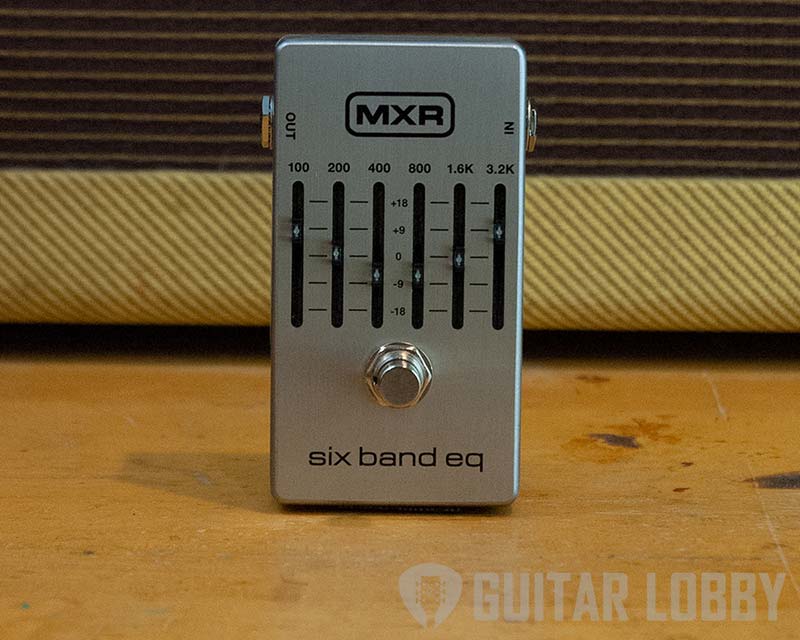
| Estimated Price | $120 |
| Type | Digital |
| Effects | EQ |
| Connectivity | 1 x 6.35mm Jack Input, 1 x Output |
| Power | 9 VDC 100mA |
My Review: For all those who’ve been obsessing over the MXR M108S but found it out of budget, here’s my advice: try the M109S. It offers pretty much all the important features of the former at a much lower price. Not to mention its compact form will take up lesser space on the pedalboard than the M108S.
I’ve tried both the pedals, and while the M109S has six adjustable sliders rather than M108S’s 10, it’s still capable of targeting frequency bands of importance for excellent high/low boost or a mid boost/scoop. So, you’re not giving up on much. Plus, the M109S can tackle ranges between 100Hz – 3.2kHz, giving you plenty of options when it comes to fine-tuning your sound.
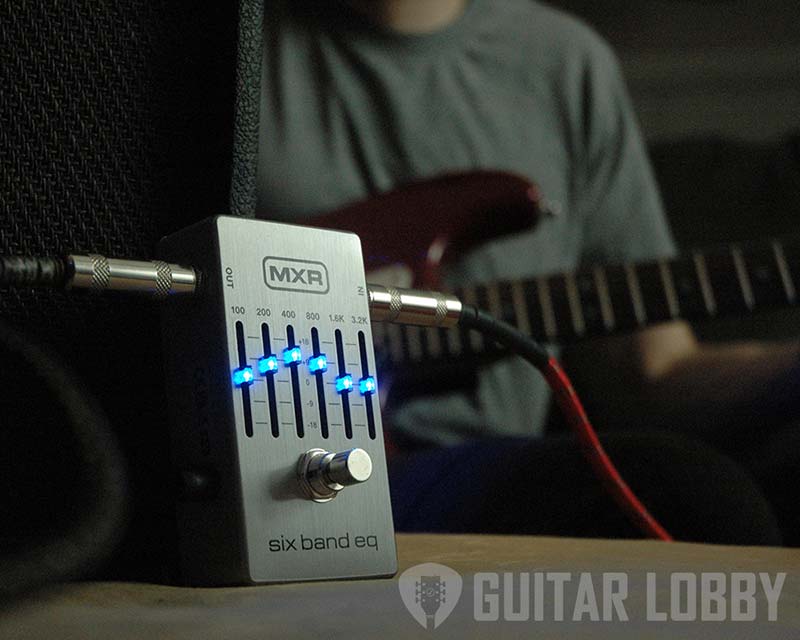
One downside to this pedal is that it doesn’t have any master volume, level, or boost controls. Maybe that won’t bother many players as this is still one of the best cheap EQ pedals available.
The absence of master volume notwithstanding, there’s plenty to love about this pedal. With true bypass switching, LED lights on each fader, and durable metal housing, this pedal is a sweet bargain. It is also well suited to a bass guitar, thanks to the low-end cuts and boosts. No wonder MXR is growing rapidly in popularity, and with the two pedals featured already on our list, it’s not hard to see why.
Who This is Best Suited for: I would recommend the MXR M109S to anyone who wants a top-quality graphic EQ pedal at a reasonable price. It’s also well suited to a crowded pedalboard, thanks to the slimline design.
Bottom Line: The MXR M109S Six Band EQ Pedal is a more concise version of the number one option on this list, with fewer faders but at a more affordable price. It still gives you the ability to tweak the main frequency bands of an electric guitar or bass and requires less power to run while still providing a good amount of headroom.
Popular Related Article: Our Favorite Overdrive Pedals (All Price Ranges)

| Name of Product | Image of Product | Description | Price Range | Full Review |
|---|---|---|---|---|
| 1. Empress ParaEQ MKII Deluxe (Editor’s Choice) |  | Type: Analog Effects: EQ | $349 | Read Full Review Below |
| 2. BOSS GE-7 (Best Value) | 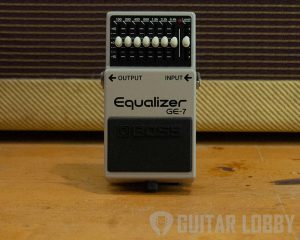 | Type: Digital Effects: EQ | $120 | Read Full Review Below |
| 3. JHS Haunting Mids | 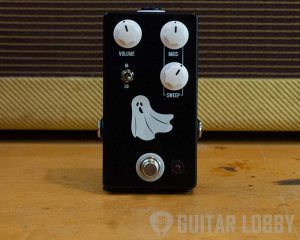 | Type: Digital Effects: EQ | $150 | Read Full Review Below |
| 4. Tech 21 Q-Strip | 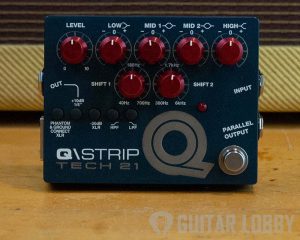 | Type: Digital Effects: EQ | $270 | Read Full Review Below |
| 5. BOSS EQ-200 | 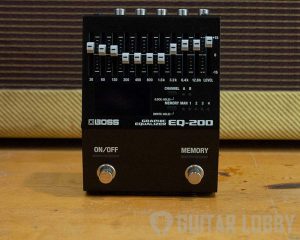 | Type: Digital Effects: EQ | $290 | Read Full Review Below |
| 6. J.Rockett Audio Designs Melody OD 6-Band EQ | 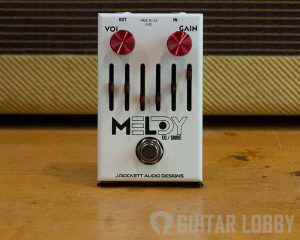 | Type: Digital Effects: EQ, Overdrive | $200 | Read Full Review Below |
| 7. MXR M108S | 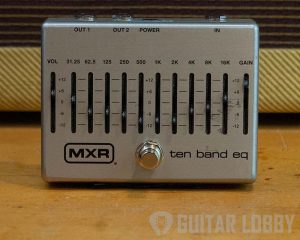 | Type: Digital Effects: EQ | $150 | Read Full Review Below |
| 8. Source Audio EQ2 | 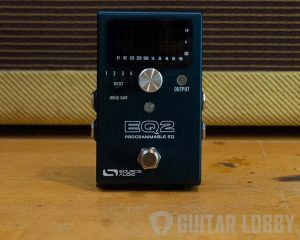 | Type: Digital Effects: EQ | $289 | Read Full Review Below |
| 9. Mesa Throttle Box EQ | 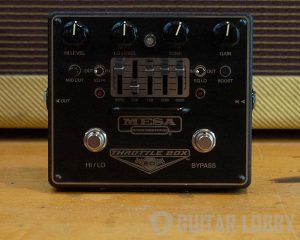 | Type: Analog Effects: EQ | $250 | Read Full Review Below |
| 10. MXR M109S (Best Under $100) | 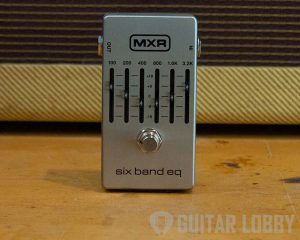 | Type: Digital Effects: EQ | $120 | Read Full Review Below |
Factors to Consider When Choosing an EQ Pedal
EQ pedals are a hugely useful tool when it comes to creating your desired tone. They are arguably the most transformative addition you can make to your pedalboard, affecting the sounds produced at their core. Not only do EQ pedals allow you to remove problem frequencies from your output, but they are also effective at controlling the frequencies produced by your other pedals.
For many years, Equalizers were mainly used in the recording studio to mix instruments and vocal tracks. In the early days of recording, engineers would use analog desks with faders that removed or added certain frequencies from the mix. It’s more common for producers to use digital plugins for their EQ now, and it’s used in basically every recording you hear.
In the next section of this article, I’ll describe in detail everything you need to know about EQ pedals, their functions, and why they are so important when it comes to sculpting your tone. We’ll go through the basic principles of EQ and get into some of the more advanced features too.
What is EQ?
When searching for effects pedals, it’s important to have some knowledge of what the specific effect does to your tone and how it is produced. Learning the theory behind an effect not only makes it easier to decide on the right option for you, but it is also valuable when it comes to recording music in the studio.
EQ or equalization as it is technically known is one of the most commonly used effects in a recording studio. It allows mixing engineers to shape the frequencies of a chosen sound with expert precision and prevents different tracks from clashing with each other. Without EQ, a mix would be chaotic and not particularly ear-friendly.
So what exactly is EQ and why is it so important? EQ is essentially the process of adjusting the frequencies that make up an audio signal. The human ear is capable of detecting frequencies between 20 Hz to 20 kHz, and music is comprised of instruments that fall within that range. Equalization allows you to tailor the frequency content of a song or in the case of pedals, a guitar, or bass.
You might be wondering, what happens when two instruments produce the same frequency. Concert A on the piano is 440Hz, so if a guitar and piano both play that particular note, how come they still sound identifiable? The answer is, they have a different timbre.
To understand EQ, we must consider timbre. Timbre affects the way the human brain processes sound and allows us to differentiate between two instruments or sound sources even when they produce the same frequency.
This brings us to partials. When we alter a sound using EQ, what we are doing is editing the volume of the sound’s particles. If a sound is composed of partials that are closely related to each other, you get a consistent, smooth, and harmonic sound, like a violin. On the other hand, if a sound is composed mostly of uneven partials, you get an inharmonic sound like a crash cymbal or open hi-hat.
Where does EQ fit into the equation? Let’s say that our electric guitar and piano are playing the same notes at the same frequencies. Although both of these instruments have distinctive timbres, they may overlap when recorded through a microphone. This overlapping can make it hard to hear the individual parts, a problem known as masking. EQ removes certain frequencies from the instruments to reduce the masking and make them audible within a mix.
It’s important to establish the EQ does not produce new frequencies. It can appear like this sometimes, but what it is doing is editing the existing characteristics of a sound rather than shaping it into something new.
The Origins of EQ
The origins of EQ date back to the 1930s, when recording and playback were in their formative stages. A sound technician named John Volkman designed the first notable external equalizer that included several adjustable frequencies.
As the decades passed, equalizers became a staple of recording studios all over the world. They were used to add clarity to vocal tracks and in the post-production process of mixing audio. When the Langevin EQ-251A came out, it marked the birth of the graphic equalizer, an invention that would revolutionize the way music and sound were mixed and produced. However, these EQs were still fairly primitive and engineers still found themselves limited to only being able to adjust certain numbers of frequency bands.
Fast forward to 1967, and the API 550A was brought into existence by Saul Walker. This model allowed mixing engineers to alter the bandwidth of recordings concerning the boosted signal. Although it still relied on fixed sections of frequencies that could be boosted or cut, it was a step up compared to previous models.
The real breakthrough came in 1966 when a team of engineers produced a sweep-tunable EQ that would remove the need for switches. The resulting 3-band EQ was frequency adjustable, providing more control over the characteristics of the sounds.
Filters, Bands & EQ pedals
Technically speaking, EQ is simply a filter that is used in a specific way. EQ uses filters to cut or boost certain frequencies. An individual EQ band is comprised of three main elements – gain, type, and slope.
As with other effect pedals, the gain adjusts how much of the EQ is present in the mix. Just as a distortion pedal’s gain control would determine how much saturation was present, the same control on an equalizer determines the amount of cut or boost the sound is subjected to.
One thing to keep in mind when using the gain control on an EQ pedal is that it affects the overall gain of your instrument’s signal. In this way, it’s similar to a gain booster. An EQ pedal has the power to change your levels dramatically, so it’s important to consider the amount of headroom you have/need on stage.
The type of filter has a massive impact on the way the EQ works. It refers to the shame of the band, and the most commonly used varieties are high/low pass, notch, bell, or high/low shelf. High-pass and low-pass filters allow the frequencies in their name to be unaffected by the filter, cutting the opposite frequencies. High-pass and low-pass filters are commonly used by DJs during breakdown sections to create tension.
The slope aspect of an EQ pedal determines the aggression of the filter where the chosen frequencies drop off. This is measured in decibels per octave, and the higher the number, the steeper the slope. For example, a slope of 6 decibels per octave would sound less severe, whereas a slope of 96 decibels per octave would be more aggressive and precise.
When it Comes to EQ, Less is More
When you first get your hands on an EQ pedal, it’s easy to fall into the trap of wanting to boost frequencies to make them more prominent in the mix. Although this seems logical, EQ is not simply a volume control, so adding more frequencies has a counteractive effect.
There are two categories that EQ falls under – these are:
- Additive EQ
- Subtractive EQ
When using an EQ pedal, it’s important not to go overboard. This effect should be used as subtly as possible, and paradoxically, the less you use it, the more power it has over your tone. Additive EQ is the practice of boosting certain frequencies to make them more audible. Subtractive EQ is when you cut out certain frequencies to make others more audible.
If you asked 100 sound engineers whether they prefer to use an additive or subtractive EQ, you’d likely get a mixed response. As is the case with all audio processing techniques, it’s a matter of personal preference. However, using subtractive EQ is generally considered to be a less aggressive way to equalize a sound. Additive EQ reduces the headroom and can cause clipping to occur if you’re not careful.
Going back to the “less is more” philosophy, if you imagine a situation where you would like to boost multiple bands on the frequency spectrum, instead of using additive EQ to make them more prominent in the mix, you could simply use subtractive EQ to cut some of the frequencies that don’t need boosting. The result is similar, but the difference is that you haven’t affected more frequencies than is necessary on your quest to boost the desired bands.
It’s important to bear in mind that EQ is not capable of transforming an undesirable sound. If your tone doesn’t sound good in the first place, EQ won’t fix that. It works most effectively when the sound source is close to the finished product that your desire, then EQ pedals are great for tweaking and refining the sound rather than correcting it.
When considering EQ as a standalone effect in the studio, a good way to think of it is as a coloration tool. A guitar track may be dull in some areas, but you may find a “sweet spot” somewhere in the mid-high frequencies. This is where EQ proves its worth, as you can minimize the appearance of unwanted frequencies, therefore drawing the listener’s attention to the best parts of the sound.
Common EQ Pedal Terminology – Summary
After reading through the previous sections, you should now have a grasp on EQ, its different aspects of it, and the terms used to describe its functions. You’ll find that some EQ pedals have all of the aforementioned qualities, whereas more basic models may be limited to only a few. Either way, it’s a good idea to familiarize yourself with the terms used to describe equalization so that you can use your pedal to the best of your ability and transfer that knowledge into your recordings.
Graphic EQ and Parametric EQ
Generally speaking, EQ pedals fall under two categories – graphic and parametric. Both ultimately perform the same function but have different appearances and parameters. In the list at the start of this article, I included a mixture of both varieties, so it’s a good idea to learn about the contrasting qualities of both types of EQ pedals.
Graphic EQ pedals have several onboard sliders. They vary from 5-band to 10-band models. The band simply means the number of sliders that are present on the face of the pedal. Stompbox EQ pedals are almost always of the graphic variety and allow you to visually see the settings in a way that represents a waveform. The advantage of graphic EQ pedals is that you can visualize the frequencies and create clear curves to either boost or cut desired frequency bands.
Parametric EQ pedals are closely based on what you would find on an original mixing desk in an analog recording studio. They have knobs instead of sliders and are better suited to guitarists who want to be as precise as possible when using their EQ pedal. The advantage of using parametric EQ is that you can perform sweeps, which allow you to find “sweet spots” within the frequency spectrum. These pedals are generally more expensive than their graphic EQ counterparts.
Recreating Lo-Fi Tones with an EQ Pedal
Another great thing about EQ pedals is that they are capable of transforming your tone to suit different styles of music. Lo-Fi is a term that describes sounds that have been edited to sound more primitive and less polished, giving them an authentic feel. It’s the opposite of hi-fi, where the instruments are mixed clearly and sound pristine.
EQ pedals are very effective at turning your guitar tone lo-fi. In terms of frequencies, lo-fi guitars are usually lacking in the low-end, due to the sub-par recording techniques used to capture them. To reproduce this kind of sound, you can roll off some of the low and low-mid frequencies from around 500Hz and below, so your EQ pedal is acting as a high-pass filter.
Filter Sweeps
Another popular effect that you can reproduce using an EQ pedal is a filter sweep. This is a technique used by electronic musicians when dealing with synths, but it can also sound interesting on a guitar. It’s used as a transitional effect in many styles of music, blending two sections seamlessly.
It’s harder to create a filter sweep effect if you are using a graphic EQ pedal because it only allows you to adjust the individual sliders of one frequency band. However, a parametric EQ pedal is more than capable of performing this effect.
The knob-styled controls on parametric EQ pedals are much easier to tweak. As you adjust the parameters, the chosen frequencies are either boosted or cut. To create a filter sweep, you need to consistently move the knobs from their lowest to the highest point. This creates a dramatic swoop between the frequency points.
Positioning an EQ Pedal in Your Signal Chain
The positioning of effects pedals in a signal chain is a frequently debated topic among guitarists. The beautiful thing about music is that there’s no one-size-fits-all approach, and it comes down to what sounds you intend to produce.
Although pedal positioning is a subjective matter, that doesn’t mean there aren’t particular methods that most musicians would agree to be the “correct” way of doing things. I’m a big believer in learning through experimentation, so feel free to disregard the next couple of paragraphs if you’d rather take a D.I.Y approach.
It’s generally accepted that dynamic pedals like compressors or gain boosters should be positioned at the start of your chain. Next comes any “dirt” based pedals like distortion, overdrive, or fuzz. EQ pedals don’t have a set position, for this reason – when you shape your sound using an EQ pedal, it will affect every other pedal that comes after it in the chain. This means you need to be selective with which other effects are positioned before the EQ.
Some guitarists use multiple EQ pedals so that they can shape the sound before and after certain effects. This is a good way to ensure that there is consistency across the output of your pedalboard, but not everyone has space or budget to purchase more than one EQ pedal.
Personally, I would favor positioning an EQ pedal towards the end of the signal chain, simply because you can then use it to its full capacity and control the frequency output of every other pedal on your board.
EQ and Vocals
There are specific pedals made for vocal EQ, but usually, it would be the job of a sound technician to set this up on the mixing desk at a venue. They have access to the level meters and so can see which frequencies need to be cut or boosted.
If you’re playing a show where there is no sound technician present for some reason, a vocal EQ pedal is a very handy solution. If you find that the acoustics of the room make some frequencies stand out more than others when you’re singing, you can simply roll them off to smoothen out the overall tone.
Signal Splitting
Signal splitting is a useful process to learn about, as it applies not only to pedals and amplifiers but mixers and other recording studio equipment too. So what is signal splitting? Basically, it’s where you send a dry and wet output from the same sound source into a pair of inputs, creating two signals from one source.
In the case of overdrive pedals, you might have noticed that some of the options I previously presented in this list were fitted with two outputs. This makes it possible to split the signal, and send the wet/dry into separate amplifiers.
The reason that guitarists and bassists use this trick is mainly to give them a thicker, more full-bodied sound. When using a dual-amp setup, your clean tone is constantly playing even when you turn on an effects pedal. So the dry signal forms the foundation of your tone, then when an effect is turned on the wet signal is sent to a separate amp. This gives the illusion that two guitars are playing the same thing with differing tones.
Splitting the signal is a great way to compensate for the lack of a second guitar in your band, or if you play the bass, you can use your effects channel as a replacement for a guitarist while maintaining the fullness of your low-end frequencies.
Using EQ in the Recording Studio
The main difference between using EQ pedals on stage and using EQ in the studio is that the latter usually consists of DAWs and plugins. The principles remain the same, but mixing songs within your Digital Audio Workspace gives you more accuracy and freedom.
There are a number of brilliant EQ plugins available, some free and some for a cost. In all honesty, you can simply use the EQ that comes with your preferred DAW, as they all do the same thing. The more high-end options usually have more advanced graphics and preset, but if you spend some time learning and experimenting with EQ you can get the same results from a more basic option.
Using your EQ pedal in the studio might be a good idea if you want to preserve and replicate your exact live tone when recording. The chances are your EQ pedal settings which stay pretty consistent once you decide on the right sound, so using the pedal to record will get you closer to the sound your guitar produces on stage.
If you decide to use your EQ pedal rather than a plugin, you have two options. Firstly, you could run your guitar straight into the pedal, then into the direct input on your audio interface. The advantage of this method is that your tone isn’t colored by an amplifier. The exact sound of your guitar and pickups is affected by the EQ, which gives you more of a blank canvas to work with when mixing the track.
Alternatively, you can run the EQ pedal into an amplifier and set up a microphone to record. This provides a more consistent sound to your on-stage tone, but it’s harder to edit the recording afterward as the characteristics of the amp will impact the captured audio.
Bass Guitar and EQ Pedals
Another great thing about EQ pedals is that they are usually compatible with electric guitars, acoustic guitar, and bass guitars. The key when using EQ with bass is to be aware of the different frequency properties compared to a standard electric guitar.
The “sweet spot” of a bass guitar is found towards the low end of the frequency spectrum. Anywhere between 200Hz-800Hz is a good place to start. By adjusting the EQ parameters whilst playing your bass, you can figure out which frequencies could do with a little boost and which need to be cut.
Anything under 100Hz is generally considered to be redundant, as the human ear struggles to pick up these frequencies. If your bass is heavy on the low end, it might be worth rolling off anything below 100Hz to avoid the tone from becoming muddy.
The best way to use effects pedals with a bass guitar is to utilize a dual-amp setup by splitting the signal, as I mentioned earlier in the article. This allows you to separate the clean and dirty channels, giving you more control over the output.
Power Requirements
EQ pedals generally require a 9-volt power source. There are a few exceptions that run off 12 volts, but this is rare. Some come with a purpose-built power supply made especially by the manufacturer, others require you to purchase one externally. Most power supplies do the same thing, so there’s nothing wrong with picking up an affordable option.
It’s also common that EQ pedals can be powered by 9-volt batteries. This is useful for situations where mains power is limited, and it can also provide some peace of mind when you’re on stage. By fitting a fresh battery into the pedal before each show, you eliminate the risk of the pedal cutting out if the power supply somehow malfunctions.
Conclusion:
EQ pedals are a highly useful addition to your setup, providing you with a platform to sculpt your tone with precision. They may not be as exciting as a fuzz or delay pedal, but they are equally, if not more important.
After reading this definitive guide on EQ pedals available today and the information section covering all of the information on the topic, you should now be in a position to make an informed choice. All of the options on this list would greatly improve your sound, so I’m, sure you’ll be happy with whichever one you choose.

My name is Chris and I’ve had a passion for music and guitars for as long as I can remember. I started this website with some of my friends who are musicians, music teachers, gear heads, and music enthusiasts so we could provide high-quality guitar and music-related content.
I’ve been playing guitar since I was 13 years old and am an avid collector. Amps, pedals, guitars, bass, drums, microphones, studio, and recording gear, I love it all.
I was born and raised in Western Pennsylvania. My background is in Electrical Engineering, earning a Bachelor’s degree from Youngstown State University. With my engineering experience, I’ve developed as a designer of guitar amplifiers and effects. A true passion of mine, I’ve designed, built, and repaired a wide range of guitar amps and electronics. Here at the Guitar Lobby, our aim is to share our passion for Music and gear with the rest of the music community.
